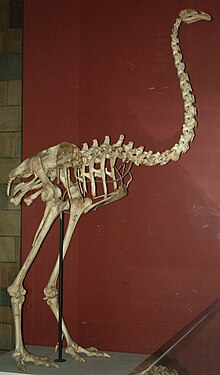| Moa | |
|---|---|

| |
| North Island giant moa skeleton | |
| Scientific classification | |
| Domain: | Eukaryota |
| Kingdom: | Animalia |
| Phylum: | Chordata |
| Class: | Aves |
| Infraclass: | Palaeognathae |
| Clade: | Notopalaeognathae |
| Order: | †Dinornithiformes Bonaparte, 1853[1] |
| Type species | |
| †Dinornis novaezealandiae Owen, 1843
| |
| Subgroups | |
|
See text | |
| Diversity[2] | |
| 6 genera, 9 species | |
| Synonyms[3] | |
| |
Moa[note 1] (order Dinornithiformes) are an extinct group of flightless birds formerly endemic to New Zealand.[4][note 2] During the Late Pleistocene-Holocene, there were nine species (in six genera). The two largest species, Dinornis robustus and Dinornis novaezelandiae, reached about 3.6 metres (12 ft) in height with neck outstretched, and weighed about 230 kilograms (510 lb)[5] while the smallest, the bush moa (Anomalopteryx didiformis), was around the size of a turkey.[6] Estimates of the moa population when Polynesians settled New Zealand circa 1300 vary between 58,000[7] and approximately 2.5 million.[8]
Moa are traditionally placed in the ratite group.[4] However, genetic studies have found that their closest relatives are the flighted South American tinamous, once considered a sister group to ratites.[9] The nine species of moa were the only wingless birds, lacking even the vestigial wings that all other ratites have. They were the largest terrestrial animals and dominant herbivores in New Zealand's forest, shrubland, and subalpine ecosystems until the arrival of the Māori, and were hunted only by Haast's eagle. Moa extinction occurred within 100 years of human settlement of New Zealand, primarily due to overhunting.[7]
- ^ Brands, S. (2008)
- ^ Cite error: The named reference
Stephensonwas invoked but never defined (see the help page). - ^ Brodkob, Pierce (1963). "Catalogue of fossil birds 1. Archaeopterygiformes through Ardeiformes". Biological Sciences, Bulletin of the Florida State Museum. 7 (4): 180–293. Retrieved 30 December 2015.
- ^ a b OSNZ (2009)
- ^ Davies, S.J.J.F. (2003)
- ^ "Little bush moa | New Zealand Birds Online". nzbirdsonline.org.nz. Retrieved 24 July 2020.
- ^ a b Perry, George L.W.; Wheeler, Andrew B.; Wood, Jamie R.; Wilmshurst, Janet M. (1 December 2014). "A high-precision chronology for the rapid extinction of New Zealand moa (Aves, Dinornithiformes)". Quaternary Science Reviews. 105: 126–135. Bibcode:2014QSRv..105..126P. doi:10.1016/j.quascirev.2014.09.025. Retrieved 22 December 2014.
- ^ Latham, A. David M.; Latham, M. Cecilia; Wilmshurst, Janet M.; Forsyth, David M.; Gormley, Andrew M.; Pech, Roger P.; Perry, George L. W.; Wood, Jamie R. (March 2020). "A refined model of body mass and population density in flightless birds reconciles extreme bimodal population estimates for extinct moa". Ecography. 43 (3): 353–364. Bibcode:2020Ecogr..43..353L. doi:10.1111/ecog.04917. ISSN 0906-7590.
- ^ Cite error: The named reference
Phillipswas invoked but never defined (see the help page).
Cite error: There are <ref group=note> tags on this page, but the references will not show without a {{reflist|group=note}} template (see the help page).